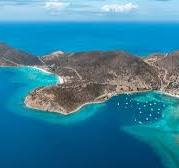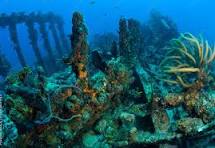Salt Island: Caribbean Legacy of Salt Production and Maritime Tragedy
Salt Island is a small, uninhabited island located in the British Virgin Islands (BVI) in the Caribbean. Despite its size and lack of permanent residents, Salt Island holds a significant historical and cultural importance in the region. The island’s name itself reflects its historical connection to the production of salt, a commodity that played a crucial role in the economic development of the Caribbean.
The history of Salt Island can be traced back to the indigenous people who inhabited the region long before the arrival of European colonizers. These original inhabitants, likely Arawak and Carib Indians, would have been aware of the natural salt ponds on the island. The indigenous peoples might have used the salt for preserving fish and meat, as well as for trading purposes within the Caribbean.
With the arrival of European explorers and colonizers in the late 15th century, the Caribbean became a focal point for European powers seeking to exploit the region’s abundant resources. The British, in particular, established a presence in the BVI, and Salt Island began to play a role in the European exploitation of the Caribbean.

Aerial view of Salt Island, BVI
The primary significance of Salt Island emerged during the colonial period when salt became a valuable commodity. The natural salt ponds on the island provided an abundant source of salt, a crucial resource for preserving food in the days before refrigeration. Salted fish, in particular, became a staple for sailors on long voyages, contributing to the growth of transatlantic trade.
The British Virgin Islands, including Salt Island, became part of the British colonial empire, and the production of salt became an essential economic activity. The salt industry on Salt Island thrived during the 18th and 19th centuries. Large salt pans were constructed on the island’s surface, where seawater was allowed to evaporate, leaving behind the valuable salt crystals. These salt pans, along with other infrastructure such as warehouses, made Salt Island a hub for salt production in the region.
The labor-intensive process of salt production relied heavily on enslaved Africans who were brought to the Caribbean to work on plantations and in various industries. Salt Island was no exception, and the forced labor of enslaved individuals played a crucial role in the island’s salt industry. The conditions for enslaved people on Salt Island, like elsewhere in the Caribbean, were harsh, and many endured unimaginable suffering.
In the 19th century, technological advancements, such as the invention of refrigeration, began to diminish the economic importance of salt production. As a result, Salt Island’s salt industry declined, and the island gradually fell into disuse. The abolition of slavery in the British Empire in the mid-19th century also had a profound impact on the demographics and labor practices of Salt Island.
Over the years, the once-thriving salt industry on Salt Island gave way to neglect and abandonment. The infrastructure associated with salt production, including the salt pans and warehouses, gradually deteriorated. However, Salt Island continued to hold historical and cultural significance, serving as a reminder of the region’s colonial past and the complex legacy of the salt industry.
In addition to its historical importance, Salt Island gained international attention due to a tragic event in the 20th century. On March 24, 1867, the RMS Rhone, a British steamship, sank near Salt Island during a hurricane. The shipwreck has since become a popular dive site, attracting underwater enthusiasts and historians alike. The submerged remnants of the RMS Rhone serve as a poignant reminder of the perils faced by sailors in the treacherous waters of the Caribbean.

Wreck of the Rhone
In the modern era, Salt Island remains uninhabited, and efforts have been made to preserve its historical and ecological value. The BVI National Parks Trust oversees the management of Salt Island, ensuring the protection of its natural environment and cultural heritage. The island’s salt pans, though in various states of disrepair, stand as silent witnesses to a bygone era.
In conclusion, Salt Island in the British Virgin Islands carries a rich history shaped by indigenous peoples, European colonization, the transatlantic slave trade, and the rise and decline of the salt industry. Its historical significance, combined with the allure of the RMS Rhone shipwreck, makes Salt Island a unique and noteworthy destination for those interested in exploring the complex layers of Caribbean history.
